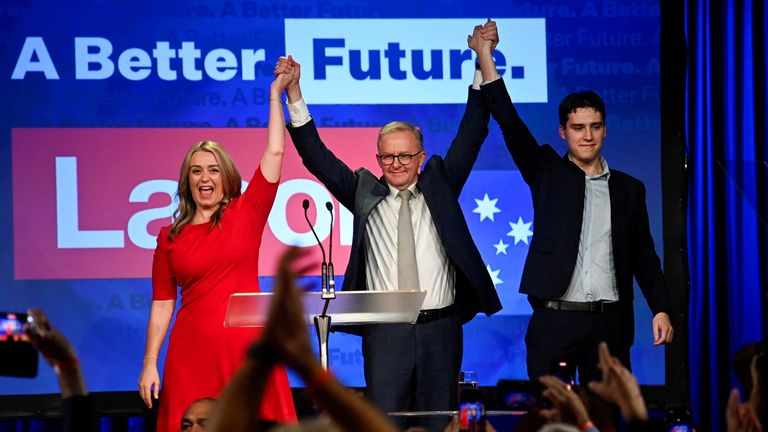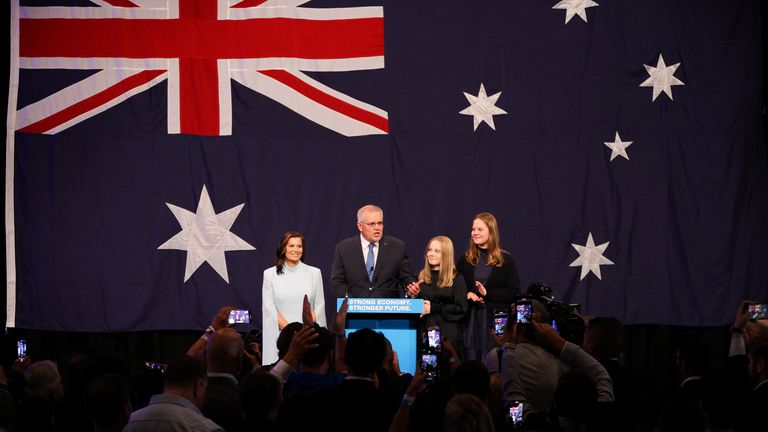[ad_1]
Australia’s newly-elected leader may have to be sworn in as acting prime minister to attend a summit with US President Joe Biden, with votes still being counted in the country’s poll.
It is still unclear whether Anthony Albanese’s Labor Party will be able to form a majority government or have to rely on the support of smaller parties and independents, who picked up seats.
However, he is due to meet in Tokyo on Tuesday with Mr Biden, Japanese Prime Minister Fumio Kishida and Indian Prime Minister Narendra Modi.
Read more: From depending on neighbours for food to the highest office – meet Australia’s new PM
Needing 76 seats to govern in its own right, Labor has been declared the winner having secured 72, with 68.5% of votes counted.
The heavily defeated conservative coalition led by the Liberal Party’s outgoing prime minister Scott Morrison has so far just 51 seats – well down from its bare-majority of 76 in the 2019 election.
This is seen as a result of voter anger over inaction on climate change after some of the worst floods and most devastating fires to hit Australia.
It means the makeup of the new parliament looks set to be much less climate-sceptic than the one that supported Mr Morrison’s pro-coal mining administration.
A total of 15 seats have been declared for independents or smaller parties.
Of these, three have been secured by the Green Party and 12 by non-aligned candidates, with up to nine of those so-called teal independents, who campaigned on policies of integrity, equality and tackling climate change.
Most of their successful candidates have been women, with their success seen partly as a rebuff to Mr Morrison for his handling of gender issues, including sex scandals that have rocked parliament during his latest three-year term.
While Labor will form either a majority or minority government, both major parties lost ground, with support for the conservative coalition dropping by more than 6% from the 2019 election, and Labor’s vote falling by around 1.2%.
Mr Albanese vowed to bring Australians together, increase investment in social services and “end the climate wars”.
Speaking to reporters while walking his dog on Sunday morning, Mr Albanese referred to a more cooperative approach to parliamentary business and described his victory as “a really big moment”.
He said: “I do want to change the country. I want to change the way that politics operates in this country.”
Green leader Adam Bandt said his party wanted to work with the next government to “tackle the climate crisis” and an “inequality crisis” he said was threatening Australia.
He said: “The Liberal vote went backwards, the Labor vote went backwards.
“More people turned to the Greens than ever before… because we said that politics needs to be done differently.”
During the campaign, Labor promised more financial assistance and a stronger social safety net as Australia wrestles with the highest inflation since 2001 and soaring housing prices.
On the foreign policy front, the party proposed to establish a Pacific defence school to train neighbouring armies in response to China’s potential military presence on the Solomon Islands, which are on Australia’s doorstep.
It also wants to tackle climate change with a more ambitious 43% reduction in greenhouse gas emissions by 2050.
Mr Morrison, who became prime minister after an internal party coup in 2018, said he would stand down as Liberal leader.
His popularity had waned dramatically since his surprise 2019 election victory, including after taking a holiday in Hawaii during Australia’s devastating bushfires in 2020.
[ad_2]



